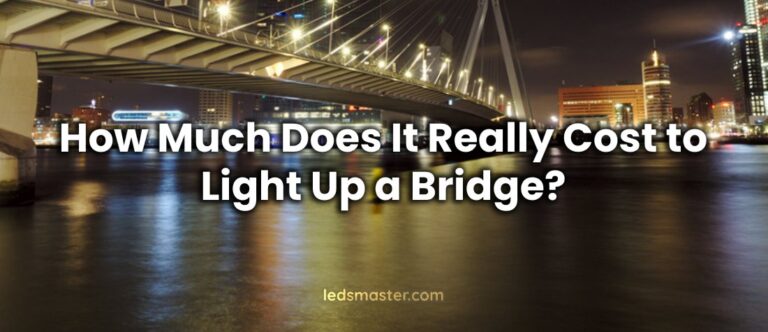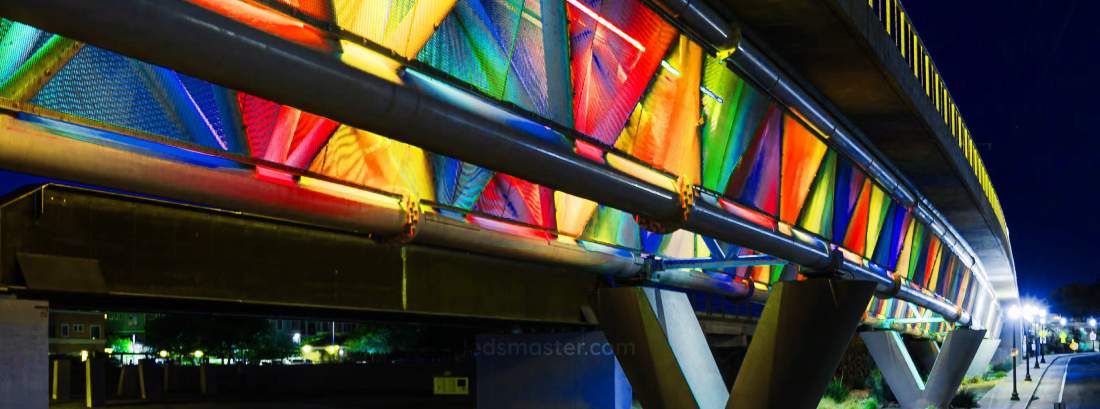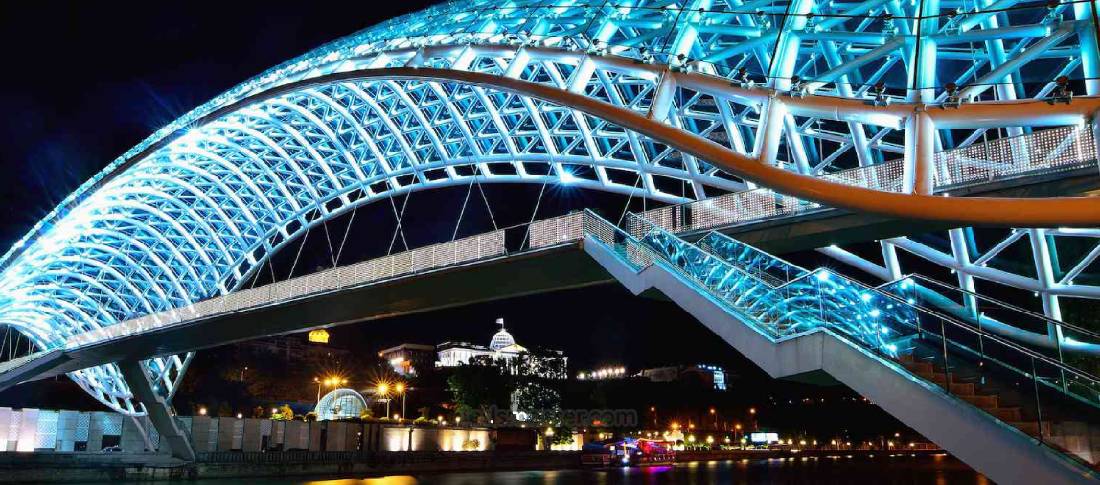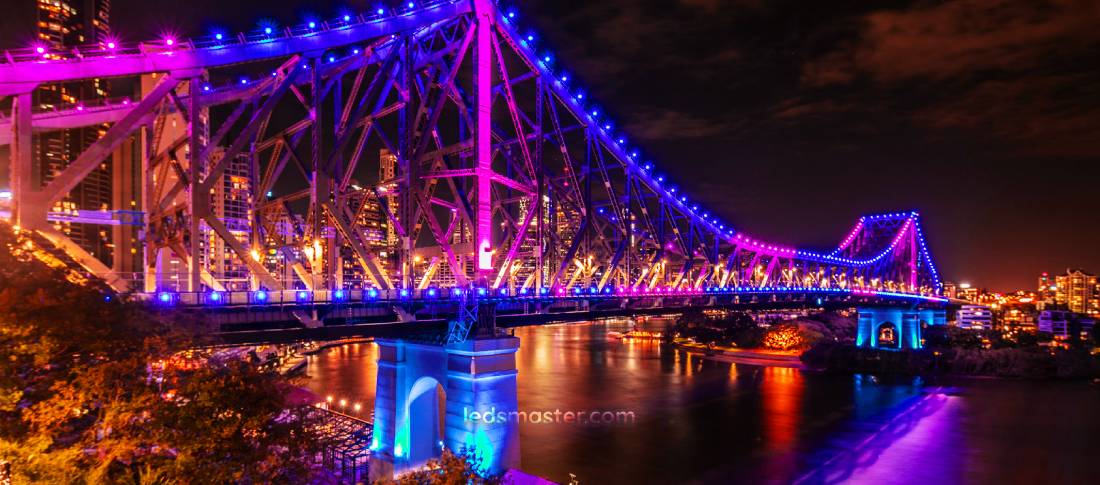
Bridge lighting combines safety, art, and innovation, and the cost of lighting is a key factor in achieving both efficiency and elegance. LED technology offers a smart balance between initial investment and long-term savings, providing a sustainable and visually impressive solution.
Get your complimentary lighting design today
LED offers enhanced energy efficiency, extended lifespan, and reduced maintenance costs compared to traditional lighting methods. A comprehensive understanding of LED bridge lighting costs and benefits is essential for informed infrastructure decisions, with LEDs providing superior light quality and long-term cost-effectiveness.
Table of Contents
ToggleThe initial setup cost for bridge lighting includes several components, such as the cost of the lighting fixtures, the design and engineering of the lighting system, and the installation process. LED lighting systems typically have a higher upfront cost compared to traditional lighting options, primarily due to the cost of the LED fixtures themselves. However, this higher initial investment is often offset by the long-term savings in energy consumption and maintenance.
The cost of LED lighting fixtures can vary significantly based on the size and type of the bridge, as well as the specific requirements of the lighting design. For instance, architectural bridges that require decorative lighting to highlight their structure may need more advanced and aesthetically pleasing fixtures, which can increase the overall cost. On the other hand, functional bridges that prioritize visibility and safety may use standard LED fixtures, which are more cost-effective.
Designing a bridge lighting system involves creating a lighting plan that ensures optimal illumination, energy efficiency, and aesthetic appeal. This process requires the expertise of lighting engineers and designers who can develop a system that meets the specific needs of the bridge. The cost of design and engineering can vary based on the complexity of the project, with more intricate designs requiring higher investments.
The installation of bridge lighting is a critical component of the overall cost. It involves not only the physical installation of the lighting fixtures but also the integration of the lighting system with the bridge’s electrical infrastructure. Installation costs can vary depending on the bridge’s size, location, and accessibility. For example, installing lighting on a large suspension bridge may require specialized equipment and labor, which can drive up costs. Additionally, the time required for installation can affect the overall cost, with more complex installations taking longer and requiring more resources.

Operating costs are a significant consideration in the overall cost of bridge lighting. These costs include the energy consumption of the lighting system, as well as any ongoing expenses related to the operation and monitoring of the system.
One of the primary advantages of LED lighting is its low energy consumption. LEDs are highly efficient, converting a large percentage of the energy they consume into light rather than heat. This efficiency results in substantial energy savings over the lifetime of the lighting system. For bridge lighting, where lights often operate for extended periods, the energy savings provided by LEDs can be particularly significant. The reduction in energy consumption not only lowers operating costs but also contributes to environmental sustainability by reducing the bridge’s carbon footprint.
Modern bridge lighting systems often include advanced monitoring and control systems that allow for real-time adjustments to the lighting levels based on traffic conditions, weather, and other factors. These systems can optimize energy usage and extend the lifespan of the lighting fixtures by reducing the intensity of the lights when full brightness is not required. While these systems can add to the initial setup cost, they often result in long-term savings by reducing energy consumption and minimizing the need for maintenance.
| Item | Specification | Price (USD) |
|---|---|---|
| LED Bridge Light Fixture | 200W LED, 120,000-hour lifespan, IP65 rating | $400 – $600 |
| Traditional Bridge Light Fixture | 400W High-Pressure Sodium, 20,000-hour lifespan, IP54 rating | $250 – $350 |
| Installation Cost (LED) | Includes labor and materials for LED fixtures | $800 – $1,200 |
| Installation Cost (Traditional) | Includes labor and materials for traditional fixtures | $1,000 – $1,500 |
| Annual Energy Cost (LED) | Based on 10,000 hours/year at $0.12/kWh | $100 – $150 |
| Annual Energy Cost (Traditional) | Based on 10,000 hours/year at $0.12/kWh | $400 – $600 |
| Annual Maintenance Cost (LED) | Includes minor repairs and occasional inspections | $80 – $120 |
| Annual Maintenance Cost (Traditional) | Includes bulb replacements and more frequent maintenance | $200 – $350 |
Maintenance costs are a significant factor in the overall cost of bridge lighting. These costs include routine maintenance, such as cleaning and replacing light fixtures, as well as any repairs needed due to damage or wear and tear.
One of the most notable benefits of LED lighting is its longevity. With a lifespan that can exceed 120,000 hours, LEDs require far less frequent replacement than traditional lighting options. This extended lifespan translates to significant savings in maintenance costs, as fewer replacements mean reduced labor and material expenses. Additionally, the durability of LED fixtures, which are resistant to shock, vibration, and extreme temperatures, further reduces the likelihood of damage and the need for repairs.
Routine maintenance for bridge lighting involves tasks such as cleaning the fixtures to remove dirt and debris, which can reduce the efficiency and brightness of the lights. While LED fixtures require less frequent maintenance than traditional lights, they still need to be cleaned periodically to maintain optimal performance. The cost of routine maintenance can vary depending on the size and accessibility of the bridge, with larger or more difficult-to-access bridges requiring more time and resources.
Despite their durability, LED lighting systems may still require repairs due to environmental factors, such as severe weather or accidental damage. The cost of repairs can vary depending on the extent of the damage and the accessibility of the lighting fixtures. However, the overall repair costs for LED systems are typically lower than for traditional lighting systems due to the inherent durability and resilience of LED fixtures.

One of the most compelling short-term benefits of LED bridge lighting is its remarkable energy efficiency. Unlike traditional lighting solutions, such as high-pressure sodium or metal halide lamps, LED lights consume significantly less energy to produce the same amount of illumination. This immediate reduction in energy consumption translates directly into lower electricity bills, providing instant financial relief for municipalities and organizations responsible for bridge maintenance. As LED technology continues to advance, the energy savings become even more pronounced, further enhancing the cost-effectiveness of the lighting system from the outset.
In addition to energy savings, LED bridge lighting significantly enhances visibility and safety. LEDs provide brighter and more uniform illumination compared to traditional lights, which improves the clarity of the bridge’s surface and its surrounding area. This increased visibility is crucial for drivers and pedestrians, as it reduces the likelihood of accidents and enhances overall safety. Moreover, better-lit bridges can lead to lower liability and insurance costs, as improved lighting conditions reduce the risk of incidents and associated claims. This immediate impact on safety and financial liability underscores the value of investing in LED lighting for bridges.
The installation process for LED bridge lighting is another advantage in the short term. Modern LED fixtures are designed with user-friendly installation in mind, which often requires less time and labor compared to traditional lighting systems. The streamlined installation process minimizes disruptions to traffic flow and bridge operations, which is especially beneficial for busy or high-traffic bridges. Reduced installation time and costs contribute to a more efficient project execution, allowing for quicker benefits from the new lighting system and less interference with daily bridge usage.
Over the long term, the most significant benefit of LED bridge lighting is the substantial reduction in maintenance costs. LED fixtures are known for their durability and longevity, often lasting up to 120,000 hours or more—up to ten times longer than traditional lighting options. This extended lifespan means that LEDs require far fewer replacements, which translates into lower costs for labor, materials, and disposal of old fixtures. Fewer maintenance activities not only reduce the financial burden but also decrease the frequency of service disruptions, ensuring that the bridge remains well-lit with minimal interruption.
The energy efficiency of LEDs also contributes to lower operating costs over time. As energy prices continue to rise, the cost savings from LED lighting become more pronounced. LEDs use significantly less power to produce the same amount of light, which means that their impact on electricity bills is substantially lower than that of traditional lighting solutions. This ongoing reduction in energy consumption translates into continued financial savings, making LED lighting a more cost-effective option in the long run. The combination of lower energy usage and reduced maintenance requirements makes LEDs an economically advantageous choice for bridge lighting.
Environmental sustainability is a crucial long-term benefit of LED bridge lighting. LEDs generate less carbon emissions due to their lower energy consumption, which contributes to a reduction in the overall environmental impact of the bridge. As governments and organizations increasingly prioritize sustainable infrastructure projects, LEDs align with these goals by offering a greener alternative to traditional lighting. The use of energy-efficient LEDs supports broader environmental initiatives, making them an attractive option for bridges that need to meet stringent sustainability standards and contribute positively to the reduction of carbon footprints.

Several factors can influence the overall cost of bridge lighting, including the type of bridge, the lighting design, and the specific requirements of the project. Understanding these factors can help in making informed decisions about the best lighting solutions for a particular bridge.
The type of bridge being illuminated can significantly impact the cost of the lighting system. For example, a simple pedestrian bridge may require only basic functional lighting, while a large suspension bridge may need more complex and decorative lighting to highlight its architectural features. The size and complexity of the bridge will also affect installation and maintenance costs, with larger bridges typically requiring more resources for both.
The design of the lighting system is another critical factor in determining the overall cost. A more intricate design that includes decorative lighting or dynamic lighting effects will generally be more expensive than a basic functional design. The choice of lighting fixtures, the placement of the lights, and the integration of control systems can all influence the final cost of the project.
Environmental factors, such as weather conditions and the surrounding landscape, can also impact the cost of bridge lighting. For instance, a bridge located in a coastal area may require lighting fixtures that are resistant to saltwater corrosion, which can increase the cost. Similarly, bridges in regions with extreme temperatures may need fixtures that are designed to withstand harsh weather conditions.
When comparing the costs of LED lighting to traditional lighting options for bridges, it is essential to consider not only the initial setup cost but also the long-term operating and maintenance costs.
As mentioned earlier, the initial setup cost for LED lighting is typically higher than for traditional lighting systems. This is due to the higher cost of LED fixtures and the design and engineering required to optimize their performance. However, this higher initial investment is often justified by the long-term savings in energy and maintenance.
LED lighting systems offer significant savings in operating and maintenance costs compared to traditional lighting. The energy efficiency of LEDs results in lower energy bills, while their extended lifespan reduces the frequency and cost of maintenance. Over the lifetime of the lighting system, these savings can more than offset the higher initial setup cost, making LED lighting a more cost-effective option in the long run.
The total cost of ownership for bridge lighting includes all costs associated with the lighting system over its entire lifespan, from initial setup to eventual replacement. When considering the total cost of ownership, LED lighting consistently proves to be the more economical choice. The combination of lower energy consumption, reduced maintenance requirements, and longer lifespan makes LED lighting the preferred option for bridge projects where long-term cost savings are a priority.
While the initial setup cost of LED lighting systems may be higher than traditional options, the long-term benefits in terms of energy efficiency, maintenance savings, and environmental sustainability make them a superior choice. By understanding the various costs associated with bridge lighting— including initial setup, operating, installation, and maintenance costs—stakeholders can make informed decisions that balance short-term expenses with long-term savings. LED technology continues to lead the way in bridge lighting, offering a cost-effective and environmentally friendly solution that meets the demands of modern infrastructure projects.